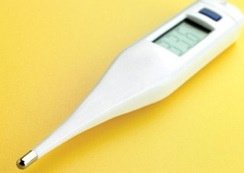-
General Health Conditions









Fever
Fever means that body temperature is above normal (about 98.6ºF).
Signs & Symptoms
-
•A temperature higher than 99.5ºF by mouth or ear or higher than 100.4ºF by rectum.
-
•The skin feels warm.
Temperatures are more accurate when they are tested inside the body, such as by ear, mouth, or rectum. Rectal temperatures are advised for children under age 3. Use a digital thermometer to measure temperature. An ear thermometer is another option.
Use a digital thermometer to measure temperature. An ear thermometer is another option.














Rest when you have a fever.
Don’t use a glass mercury thermometer. If it breaks, droplets of toxic mercury can be released. If this happens, don’t use a vacuum or broom to clean up the mercury. Call your local health or fire department to find out what to do.
Causes
Fever is usually a sign of another problem, such as an infection.
Body temperature changes during the day. It is usually lowest in the morning and highest in the late afternoon and evening. Other factors can increase body temperature. These include:
-
•Wearing too much clothing.
-
•Exercise.
-
•Hot, humid weather.
-
•Taking a temperature by mouth after drinking a hot liquid like tea.
Treatment
Treatment includes self-care measures and treating the cause.

Self-Care / Prevention
-
•Drink lots of fluids, such as fruit juice, water, etc.
-
•Take a sponge bath with warm (about 70ºF) water. Don’t use cold or cool water. Don’t use rubbing alcohol.
-
•Take the right dose of an over-the-counter medicine to reduce fever.
-
•Rest.
-
•Don’t do heavy exercise.
-
•Don’t wear too many clothes. Don’t use too many blankets.
Do any of these statements apply?
-
•The fever went away for more than 24 hours, but came back.
-
•The fever came soon after a visit to another country.
-
•A fever and feeling dizzy came after having a DTaP or MMR vaccine.
Has the person with the fever recently been in the hospital or had surgery? Or, does the person have a chronic illness, such as asthma, heart disease, lung disease, kidney disease, cancer, or diabetes?
Do any of these problems occur?
-
•Fever between 99.5ºF and up to 100.4ºF in an infant less than 3 months old.
-
•Fever of 102.2ºF and up to 104ºF in a child 3 months to 3 years old.
-
•Fever over 104ºF in a person between 3 years old and 64 years old.
-
•Fever of 102ºF or higher in a person age 65 or older or in a person whose immune system is lowered.
Has the fever lasted longer than 3 days without getting better?
With a fever, do any of these signs occur?
-
•Pain, redness, and swelling anywhere on the body.
-
•Ear pain that persists or pain in the sinuses (face).
-
•Pain in the chest with deep breaths.
-
•Sore throat.
-
•Green, yellow, or bloody-colored discharge from the nose, ears, or throat. A cough with colored phlegm.
-
•Pain or burning feeling when passing urine or passing urine often.
-
•Abnormal vaginal pain, discharge, or bleeding.
With a fever, do any of these signs occur?
-
•Shortness of breath or a hard time breathing.
-
•Stiff neck; severe, headache that lasts; nausea or vomiting; and the person can’t be roused.
-
•Acting very cranky.
-
•Confusion. Mental status changes.
-
• Severe pain in the abdomen.
Does an infant or child up to 3 years old have any of these problems?
-
•Temperature of 100.4ºF or higher in a baby less than 3 months old.
-
•Temperature of 104ºF or higher in a child between 3 months and 3 years old.
-
•The child with a fever is crying and can’t be consoled.
Questions to Ask






Copyright © 2009, American Institute for Preventive Medicine. All rights reserved.